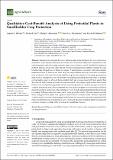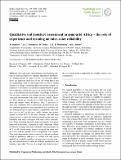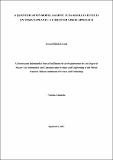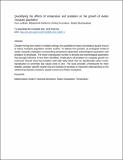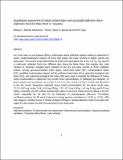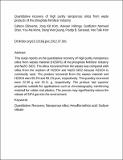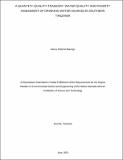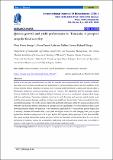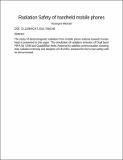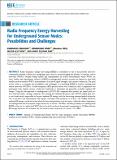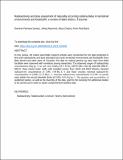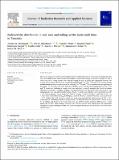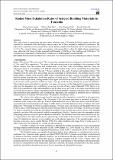Browsing by Title
Now showing items 2004-2023 of 2558
-
Qualitative Cost-Benefit Analysis of Using Pesticidal Plants in Smallholder Crop Protection
(MDPI, 2021-10-15)Assessing the potential drivers of farmers using pesticidal plants for crop protection is essential for wider adoption. However, few studies have focused on collaborative assessments of the underlying trade-offs when ... -
Qualitative soil moisture assessment in semi-arid Africa – the role of experience and training on inter-rater reliability
(Copernicus Publications, 2015-08-10)Soil and water management is particularly relevant in semi-arid regions to enhance agricultural productivity. During periods of water scarcity, soil moisture differences are important indicators of the soil water deficit ... -
Quality Assessment of Formulated Osmotically Dehydrated Cashew Apple (Anacardium occidentale L.) Slices Dried using Hot air and Solar Driers
(International Journal of Biosciences, 2020-12-28)Cashew apples are rich in phytochemicals particularly vitamin C and yet are highly underutilized in low technological countries. This study investigated the effect of drying methods on quality attributes of osmotically ... -
A quantification model against tuta absoluta effects on tomato plants: a computer vision approach
(NM-AIST, 2021-09)Tomatoes are among the most commonly cultivated crops in the world. It is considered a high value crop and income resource for smallholder farmers in Africa. Nevertheless, its production currently endangered by Tuta ... -
Quantification of deadwood littered by Acacia spp. in semi-arid ecosystems of central Tanzania: The role of deadwood in biodiversity conservation
(Journal of Biodiversity and Environmental Sciences, 2021-06-30)Deadwood (DW) is an important carbon component for conservation and management of biodiversity resources. They are ubiquitous in many semi-arid ecosystems although its estimation is still posing lots of challenges. At ... -
Quantifying nutrient re-distribution from nutrient hotspots using camera traps, indirect observation and stable isotopes in a miombo ecosystem, Tanzania
(Elsevier B.V., 2020-09)Nutrient hotspots strongly attract mammalian herbivores in nutrient-poor habitats such as savanna systems. However, little is known about their seasonal importance for mammalian herbivore species, particularly grazers. ... -
Quantifying the effects of temperature and predation on the growth of Aedes mosquito population
(Springer Nature, 2023-01-10)Despite having been tested in multiple settings, the quantitative impact of predatory aquatic insects to reduce mosquito population remains unclear. To address this question, an ecological model of Aedes mosquito population ... -
Quantifying the Occurrence and Ameliorating the Properties of Non-responsive Soils by Inorganic and Organic Fertilizers
(International Journal of Plant & Soil Science, 2015-11-30)Conventionally, crop production in sub-Saharan Africa (SSA) depends primarily on natural soil nutrients. Application of inorganic and organic fertilizers is an important way for maximizing agriculture in SSA that targets ... -
Quantitative assessment of metal contamination and associated pollution risk in sediments from the Mara River in Tanzania
(Springer Nature Switzerland AG., 2020-10-21)For most rivers in sub-Saharan Africa, information about pollution indices related to sediments is sparse. Sedimentological research of rivers that empty into Lake Victoria is highly patchy and wide apart. The present study ... -
Quantitative recovery of high purity nanoporous silica from waste products of the phosphate fertilizer industry
(Elsevier, 2013-01-25)This study reports on the quantitative recovery of high purity nanoporous silica from wastes material (H2SiF6) of the phosphate fertilizer industry and Na2O·SiO2. The silica recovered from the wastes was compared with ... -
A quantity-quality tradeoff: Water quality and poverty assessment of drinking water sources in Southern Tanzania
(NM-AIST, 2023-06)Regardless of being essential for human survival, access to potable water is still a problem in many rural African communities with increasing exposure to waterborne illnesses. This study aimed at establishing accessible ... -
Quinoa growth and yield performance in Tanzania: A prospect crop for food security
(International Journal of Biosciences, 2020-03-30)Quinoa is an emerging potential cereal crop that has recently been recommended for food security worldwide. This study was to evaluate growth and yield performance of quinoa genotypes under rain-fed conditions at the Nelson ... -
Rabbit urine and sunflower oil reinforced tephrosia-based formulation for cowpea insectpests management in Singida, Tanzania
(NM-AIST, 2023-07)Insect pests are a major problem in cowpea production. Synthetic pesticides are used to control; however, are non-friendly to human and diversity of organisms. These negative effects raise farmers' interest in botanical ... -
Radiation Safety of handheld mobile phones
(IEEE, 2014-07)The study of electromagnetic radiation from mobile phone antenna towards human head is presented in this paper. The simulation of radiation emission of Dual band PIFA for GSM and Quadrifillar Helix Antenna for satellite ... -
Radio Frequency Energy Harvesting for Underground Sensor Nodes: Possibilities and Challenges
(IEE ACCESS, 2024-03-28)Radio frequency energy harvesting (RFEH) is considered as one of the possible and envi- ronmentally friendly solution for energizing sensor devices and prolonging the lifetime of wireless sensor networks (WSNs). Despite ... -
Radio Frequency Identification based Drug Management and Monitoring System: A Case of Public Hospitals in Tanzania
((IJCSIS) International Journal of Computer Science and Information Security, 2015-08)RFID is an automatic identification technology that enables tracking of people and objects. Recently, the RFID technology has been deployed in hospitals for patient and equipment tracking, surgical equipment monitoring, ... -
Radioactivity and dose assessment of naturally occurring radionuclides in terrestrial environments and foodstuffs: a review of Bahi district, Tanzania
(International Journal of Environmental Health Research, 2023-07-13)In this review, the online searchable research articles were scrutinized for the data presented in line with radioactivity and dose estimates from both terrestrial environments and foodstuffs from Bahi district and other ... -
Radioactivity and dose assessment of naturally occurring radionuclides in terrestrial environments and foodstuffs: a review of Bahi district, Tanzania
(Taylor & Francis, 2023-07-15)In this review, the online searchable research articles were scrutinized for the data presented in line with radioactivity and dose estimates from both terrestrial environments and foodstuffs from Bahi district and other ... -
Radioactivity distribution in soil, rock and tailings at the Geita Gold Mine in Tanzania
(Elsevier B. V., 2025-04-30)This study evaluated the activity concentrations of natural radionuclides in soil, waste rocks and tailings from the Geita gold mining site in Tanzania using high-resolution gamma spectroscopy. A total of 41 samples: 31 ... -
Radon Mass Exhalation Rates of Selected Building Materials in Tanzania
(Journal of Environment and Earth Science, 2015)This study aimed at determining the mass radon exhalation rate of Tanzania Portland cements and their raw materials for assessment of the radiological hazards due to use of those materials in residential construction. ...

